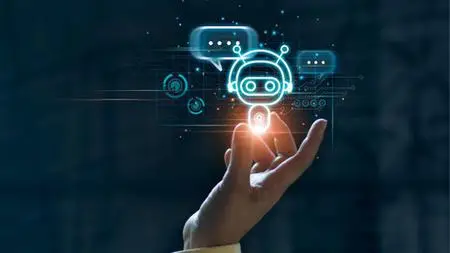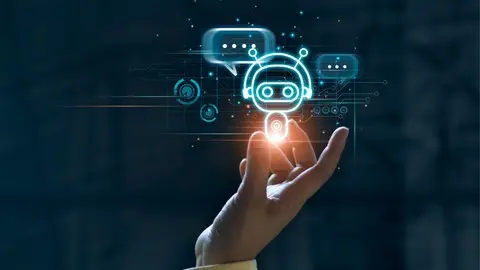Practical Natural Language Processing - Go From Zero To Hero
Published 2/2023
MP4 | Video: h264, 1280x720 | Audio: AAC, 44.1 KHz
Language: English | Size: 7.86 GB | Duration: 20h 0m
Published 2/2023
MP4 | Video: h264, 1280x720 | Audio: AAC, 44.1 KHz
Language: English | Size: 7.86 GB | Duration: 20h 0m
Learn Natural Language Processing (NLP) Creating Chatbot ,RASA, ChatGPT , BERT, Transformers, Hugging Face , Open AI GPT
What you'll learn
Text Preprocessing using NLTK and Spacy
How to work on NLP pipeline
Perform Tokenization
Stemming & Lemmatization
Apply Word Embeddings
NLP Pipeline for various tasks
Named Entity Recognition
Text Summarization
Building an Enterprise Grade Chatbot with Dialogflow
Building a project on Twitter Tweets
Build Chatbot with RASA with Advanced Integration
Deep Learning for Sequence Data
Transformer NLP Architecture
ChatGPT
BERT Model
Hugging Face Transformers
Requirements
Access to Google Colab/Jupyter Notebook
Basic to Intermediate Python Programming skills
Optional – GCP free trial account
Description
Practical Natural Language Processing - Go form Zero to HeroNatural language processing (NLP) is a field of computer science, artificial intelligence, and linguistics concerned with the interactions between computers and human (natural) languages. As its name suggests, NLP is about developing techniques to process and analyze large amounts of natural language data.NLP is an important field because it helps us to better understand human communication. By developing algorithms that can automatically process and analyze language data, we can gain insights that would not be possible through manual methods. Additionally, NLP can be used to build applications that humans can interact with more easily and efficiently, such as chatbots and voice-activated assistants.There are many benefits to learning natural language processing. Here are just a few:NLP can help you to better understand human communication.NLP can be used to build applications that humans can interact with more easily and efficiently.NLP can help you to automate tedious tasks such as information extraction from unstructured text data.NLP can improve the usability of search engines and other information retrieval systems.Learning NLP can open up career opportunities in a variety of industries, including software development, data science, and marketing.NLP is an interdisciplinary field, which means that it draws on knowledge from a variety of disciplines, including linguistics, computer science, artificial intelligence, and psychology.NLP is a rapidly growing field with exciting new research being published all the time.We have designed this course such a way that, as a practitioner you will learn the core topics described below:A Collection of Important Sections to help you understand the uniqueness of Text data and the methods to process it:In the Learning Journey, you will the Important Topics in Text Processing like :Text PreprocessingWorking on NLP pipelineTokenizationStemmingLemmatizationWord EmbeddingsNLP Pipeline for various tasksNamed Entity RecognitionText SummarizationBuilding an Enterprise Grade Chatbot with Dialogflow :In this section, you will build an Enterprise Grade Chatbot using the Widely used Platform Google Cloud Platform service - DialogFlow. In the course of the journey, you will learn how to build the chatbot from scratch, and get the advantage of the Advanced Machine Learning models of Google, and use it with few clicks, and ready to implement for your own projects.Building a project on Twitter Tweets:In the Hands On Project of this section, you will learn about working with Social Media Platform - Twitter, learn how to make use of Tweepy library , perform data extraction, data mining, data preprocessing on text data, and then create World Cloud on the Basis of Tweets created on Realtime. Its a End to End Project.Build Chatbot with RASA with Advanced Integration:Rasa is an open-source chatbot framework that helps businesses build contextual assistants. It is a set of tools that enables businesses to build, train, and deploy AI-powered chatbots. With Rasa, businesses can provide their customers with engaging and personalized experiences at scale. In this course, you will learn about its Business Use case , its implementation from scratch and integration with Slack channel so that you can start using on your projects. The chatbot can also retrieve the News from New York Times website that can answer as per the user request.Deep Learning for Sequence Data:Apart from the ML aspects, we are also going to consider the Deep Learning Neural Networks to work with text data. Recently, the progress of NLP research on text classification has arrived at the state-of-the-art (SOTA). It has achieved terrific results, showing Deep Learning methods as the cutting-edge technology to perform such tasks. As part for your learning journey, you will learn about the Recurrent Neural Networks, LSTM Neural Networks and Attention Mechanism for Encoder-Decoder Architecture.Transformer NLP Architecture:Transformer NLP is a type of NLP that uses a deep learning approach to solve natural language tasks. This technology has revolutionized the way businesses process and analyze language-based data, making it easier than ever before to extract meaningful insights from large amounts of text. Let's take a look at how Transformer NLP works and how it can be used in the business world. ChatGPT:ChatGPT is a revolutionary new AI technology that can help businesses save time and money. It stands for “Chatbot Generated Processes and Tasks”, and it uses natural language processing (NLP) to automate mundane business tasks such as customer support, onboarding, training, sales and marketing. I You will learn the intuition behind the ChatGPT in this course.BERT Model:BERT stands for Bidirectional Encoder Representations from Transformers. It is a type of artificial intelligence (AI) designed to understand natural language better than ever before. It can be used for tasks such as sentiment analysis, question-answering, and text summarization. The technology was created by Google AI researchers who wanted to create a more robust system for understanding human language. You will explore in this course about the core Architecture of BERT in this sectionHugging Face Transformers:Hugging Face transformers is a platform that provides the community with APIs to access and use state-of-the-art pre-trained models available from the Hugging Face hub. In the Advanced Modules of this course, you will learn how to implement the State of the Art Models from the Hugging Face Hub, and implement it on the Hands On manner.
Overview
Section 1: Introduction to Natural Language Processing
Lecture 1 Why NLP and how its different from Normal ML ?
Lecture 2 Understanding Human Language
Lecture 3 Challenges of NLP
Lecture 4 Summary
Section 2: Pipeline of NLP
Lecture 5 NLP Pipeline
Lecture 6 Data Extraction and Text Cleaning hands On
Lecture 7 Introduction to NLTK library
Lecture 8 Tokenization , bigrams, trigrams, and N gram - Hands on
Lecture 9 POS Tagging & Stop Words Removal
Lecture 10 Stemming & Lemmatization
Lecture 11 NER and Wordsense Disambiguation
Lecture 12 Introduction to Spacy Library
Lecture 13 Hands On Spacy
Lecture 14 Summary
Section 3: NLP -Text Vectorization
Lecture 15 Vector Representation of Text - One Hot Encoding
Lecture 16 Understanding BoW Technique
Lecture 17 BoW Hands On
Lecture 18 TF-IDF
Lecture 19 TF-IDF Hands On
Section 4: Word Embeddings
Lecture 20 Introduction to Word Embeddings
Lecture 21 Intuition of Vector Representation
Lecture 22 Hands On Word Embeddings - Usage of Pre-trained models
Lecture 23 Skip-gram Word Embeddings - Understanding Data Preperation
Lecture 24 Skip Gram Model Architecture
Lecture 25 Skip Gram Hands On - Deep Dive
Lecture 26 CBOW Model Architecture & Hands On
Lecture 27 Hyperparameters - Negative Sampling and Sub Sampling
Lecture 28 Practical Difference between CBOW and Skip-gram
Lecture 29 Bonus : How does a Network is trained - Back-propagation
Lecture 30 Section Summary
Section 5: End to End Pipeline for Text Classification
Lecture 31 General Pipeline for Classification
Lecture 32 Approaches to Classification
Lecture 33 Loading the Dataset
Lecture 34 Exploratory Data Analysis & Text Preprocessing
Lecture 35 Remove Low Frequency Words
Lecture 36 Remove Stop Words with Stemming & Lemmatisation
Lecture 37 Application of Model
Lecture 38 TfIDF Approach
Lecture 39 Challenges of NLP & N-grams
Section 6: Information Extraction
Lecture 40 Introduction to NER
Lecture 41 Understanding CRF - Introduction
Section 7: Chatbots - Build with Google Cloud Service - Dialogflow
Lecture 42 Understanding Chatbots
Lecture 43 Building a Simple Chatbot
Lecture 44 Hands On Building a Simple FAQ Chatbot
Lecture 45 Types of Chatbot and Pipeline for Chatbot
Lecture 46 Terminologies in Chatbot
Lecture 47 Dialog flow - Introduction
Lecture 48 Basics of Dialogflow
Lecture 49 Dialogflow system setup
Lecture 50 Create Dialogflow chatbot
Lecture 51 Dialogflow Fulfilment
Lecture 52 Dialogflow Integrations/Deployment
Lecture 53 Dialogflow Miscellaneous Tools
Section 8: Deep Dive into the Dialog Systems (Chatbot)
Lecture 54 Deep Dive into the components of Dialog System
Lecture 55 Dialog Intent Prediction
Lecture 56 Deep Learning based intent Classification
Section 9: Project - Build Chatbot using RASA
Lecture 57 Project Files for RASA
Lecture 58 Introduction to RASA Chatbot
Lecture 59 Installation of RASA
Lecture 60 RASA project Structure
Lecture 61 RASA Files
Lecture 62 Basics of YAML
Lecture 63 Building the chatbot - Add intents and Response
Lecture 64 Building the chatbot - Extract Entity & working with Slots
Lecture 65 Create API Key from NyTimes
Lecture 66 Working with Action File - Demo
Lecture 67 Building Custom Action File
Lecture 68 Test the Action Server
Lecture 69 RASA Pipeline file
Lecture 70 RASA Deployment - Integration with RASA Chatbot - Pre-requisites
Lecture 71 Run Ngork on RASA Chatbot with Actions
Lecture 72 Slack Settings for Connection to RASA Chatbot
Lecture 73 Practice Project Concert Chatbot & Summary
Section 10: Text Summarization
Lecture 74 Text Summarization - Introduction
Lecture 75 Hands On Text Summarization
Section 11: NLP Project - Analyze Tweets from Twitter
Lecture 76 Importance of Social Media Platforms
Lecture 77 Setting Up Twitter Developer Account
Lecture 78 Introduction to Tweepy
Lecture 79 Hands On Implementation of Project
Section 12: Section 11 : Introduction to Transformers
Lecture 80 NLP Transformers - Introduction
Lecture 81 Feed Forward Neural Network and Challenges
Lecture 82 RNN - Recurrent Neural Networks
Lecture 83 LSTM - Long Short Term Memory Networks
Lecture 84 Attention Mechanism - Attention is all you Need
Lecture 85 Transfer Learning
Lecture 86 Transformer Architecture Overview
Lecture 87 Additional Video on Transformers
Section 13: Working with Hugging Face Library
Lecture 88 Introduction to Hugging Face Library
Lecture 89 Working with Hugging Face Library Pipeline
Lecture 90 Text Classification with HuggingFace Transformers - Data Loading
Lecture 91 Tokenization using Huggingface
Lecture 92 Tokenization on Dataset
Lecture 93 Text Classification with Feature Extraction
Lecture 94 Finetuning on Transformers
Section 14: ChatGPT-3
Lecture 95 Working with ChatGPT-3
Section 15: Section 14: Advanced NLP Models - BERT
Lecture 96 Working of BERT Language Model
Anyone who wants to learn natural language processing (NLP),Anyone interested in artificial intelligence, machine learning, deep learning, or data science,Anyone who wants to build Advanced NLP models and implement in a project,Anyone who wants to create Enterprise Grade Chatbots



